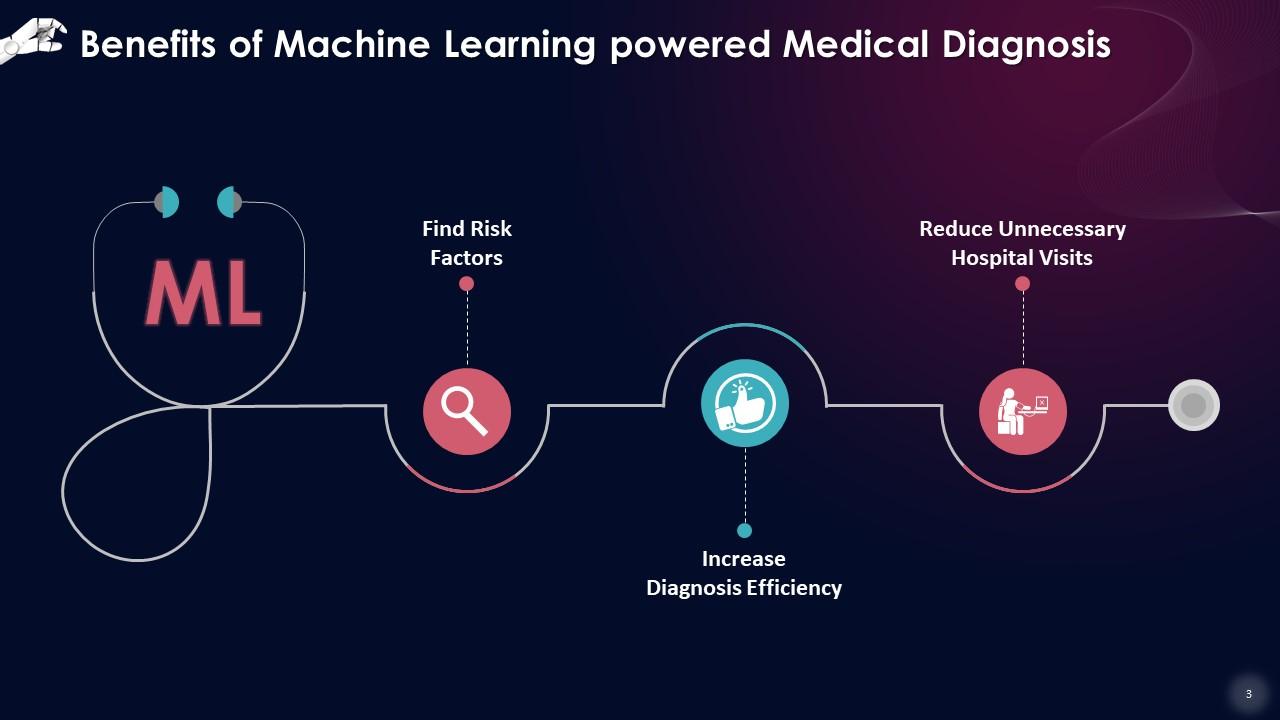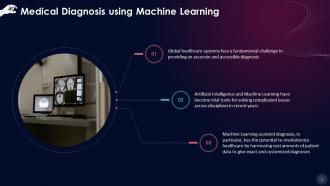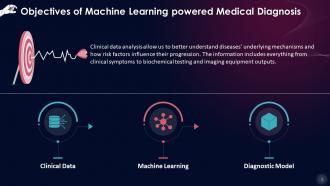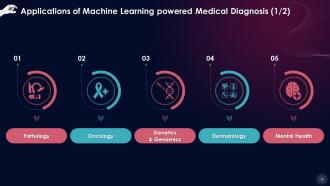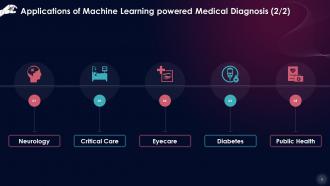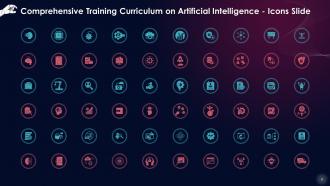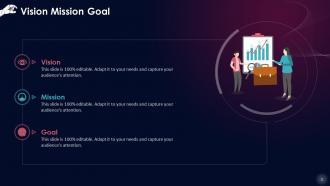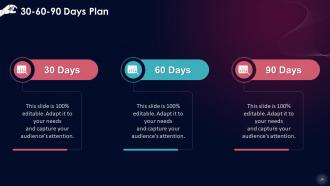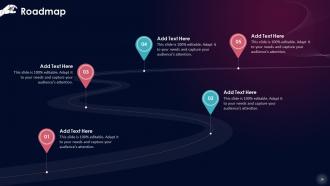Empowering Medical Diagnosis With Machine Learning Training Ppt
These slides illustrate the importance of Machine Learning in Medical Diagnosis. Artificial Intelligence and Machine Learning have become vital tools for solving complicated issues in disciplines in recent years. Machine Learning can enhance the diagnostic model based on the information that clinical data provides. The information includes everything from clinical symptoms to biochemical testing and imaging equipment outputs.
You must be logged in to download this presentation.
 Impress your
Impress your audience
Editable
of Time
PowerPoint presentation slides
Presenting Empowering Medical Diagnosis with Machine Learning. These slides are 100 percent made in PowerPoint and are compatible with all screen types and monitors. They also support Google Slides. Premium Customer Support available. Suitable for use by managers, employees, and organizations. These slides are easily customizable. You can edit the color, text, icon, and font size to suit your requirements.
People who downloaded this PowerPoint presentation also viewed the following :
Content of this Powerpoint Presentation
Slide 1
This slide illustrates the importance of Machine Learning in Medical Diagnosis. Artificial Intelligence and Machine Learning have become vital tools for solving complicated issues in disciplines in recent years. Machine Learning-assisted diagnosis, in particular, has the potential to revolutionize healthcare by harnessing vast amounts of patient data to give exact and customized diagnoses.
Slide 2
This slide depicts how Machine Learning can enhance the diagnostic model based on the information that clinical data provides. The information includes everything from clinical symptoms to biochemical testing and imaging equipment outputs.
Instructor’s Notes: Data types that can be used to achieve a precise medical diagnosis using Machine Learning are:
- Disease Data: Physiological measures and data on recognized diseases or symptoms are examples of disease data
- Environmental Data: Information concerning a person's exposure to the environment, such as smoking, sunbathing, and weather conditions
- Genetic Data: All or a significant portion of an individual's DNA sequence is referred to as genetic data
Slide 3
This slide lists the advantages of Machine Learning in Medical Diagnosis such as finding risk factors, increased diagnosis efficiency, and reducing unnecessary hospital visits.
Instructor’s Notes:
- Find Risk Factors: Find out which factors are most closely linked to the chance of contracting an illness
- Increase Diagnosis Efficiency: Diseases can be diagnosed earlier and more precisely
- Reduce Unnecessary Hospital Visits: Visits to the hospital should only be made when the patient actually requires medical attention
Slide 4
This slide highlights applications of Machine Learning in Medical Diagnosis. These applications include pathology, oncology, genetics & genomics, dermatology, and mental health.
Instructor’s Notes:
- Pathology: Given the shortage of pathologists globally, there is a solid case for using Machine Learning to advance this discipline. Pathology is also profitable for Artificial Intelligence applications due to the necessity to analyze massive datasets. Machine Learning can improve the precision of blood and culture analysis by automating tissue and cell quantification, mapping disease cells, and flagging areas of interest on a medical slide. It can also help create tumor staging paradigms and increase the speed of profile scanning to improve healthcare professionals' productivity
- Oncology: In oncology, the relevance of finding a malignant tumor early on is critical, and this is why diagnostic accuracy and precision are crucial. Oncologists can use Machine Learning to detect cancer in its early stages. Medical experts can detect somatic mutations using techniques like DeepGene (a somatic mutation is an acquired change in a genetic code of one or more cells)
- Genetics & Genomics: Machine Learning and Artificial Intelligence (AI) are essential components of preventive genetics. Scientists are using algorithms to determine how medications, chemicals, and environmental variables affect human DNA
- Dermatology: Physicians anticipate that the use of Machine Learning in this discipline will reduce the number of needless biopsies that dermatologists must perform. There are functional Machine Learning implementations available, including an algorithm that distinguishes melanomas from benign skin lesions with greater precision than a human, tools that track the development and changes in skin moles. It can also assist in detecting pathological conditions and algorithms that pinpoint biological markers for acne, nail fungus, and seborrheic dermatitis
- Mental Health: Through Machine Learning, Artificial Intelligence can have a revolutionary impact on mental health research and the efficiency of medical diagnostics. Personalized cognitive behavior therapy (CBT) powered by chatbots and virtual therapists, and mental disease prevention using Machine Learning techniques can help high-risk groups avoid social isolation. It can also aid in identifying groups at high risk of suicide and provide them with support and assistance. Machine Learning is being used to diagnose clinical depression, bipolar disorder, anxiety, and other mental diseases
Slide 5
This slide highlights applications of Machine Learning in Medical Diagnosis. These applications include neurology, critical care, eyecare, diabetes, and public health.
Instructor’s Notes:
- Neurology: Incorporating Machine Learning into the collection, processing, and interpretation of research data benefits neuroscience and neurology. Innovative technologies are critical for pushing the frontier of neurological research, from processing scans to providing insights into the human brain and recognizing behavior patterns
- Critical Care: In the ICU, Machine Learning can assist clinicians in identifying high-risk patients, ensuring that no early signs of deterioration are ignored. Innovative technologies can offer clinicians information on their ICU patients' health. Intensive care clinicians, for example, discovered that delirious patients are more responsive to light (than noise) through the use of technology
- Eyecare: AI-driven vision screening tools that help deliver a point-of-care medical diagnosis based on Machine Learning for ophthalmological diseases are among the most recent developments that healthcare centers are using. It also aids in detecting Diabetic Retinopathy and providing treatment insights to physicians by evaluating patient data. High-precision glaucoma and cataract screening can also be done with the implementation of Machine Learning
- Diabetes: Machine Learning can aid in this area by using vector machine modeling and developing neural networks for pre-diabetes screening, establishing tools for managing tailored insulin delivery, and creating artificial pancreas systems. It can help identify genetic and other indicators for diabetes and predict treatable problems in diabetic patients to improve their quality of life
- Public Health: Healthcare workers can use Machine Learning to expand the scope of medical diagnostics and shift from examining individual cases to monitoring communities and anticipating illness outbreaks
Slide 6
This slide depicts the frontrunners in the field of medical diagnosis that have implemented Machine Learning. These include Google Health, Corti, IBM Watson Health, and MedX.
Instructor’s Notes:
- Google Health: Google Health teamed up with the DeepMind team to develop a breast cancer diagnosis algorithm. The resulting system was a significant success, outperforming human radiologists in diagnostic precision
- Corti: Corti is an AI-based software that assists emergency room physicians in extracting information from patient interactions. In addition to evaluating the substance of the conversation, the system records the caller's vocal intonations and analyses background noise to give medical personnel a complete picture of the situation on the ground
- IBM Watson Health: Watson Health recently unveiled an innovative breast cancer early detection program. Biorasi, a platform for optimizing drug manufacturing, was also developed by the business
- MedX: This Silicon Valley business is revolutionizing healthcare using data science and predictive analytics. Rather than focusing on direct contact between doctors and patients, the company provides tools for making smart operational decisions
Empowering Medical Diagnosis With Machine Learning Training Ppt with all 22 slides:
Use our Empowering Medical Diagnosis With Machine Learning Training Ppt to effectively help you save your valuable time. They are readymade to fit into any presentation structure.
-
Like always a great experience with you guys. Always there on the drop of hat to help.
-
Well-designed and informative templates. Absolutely brilliant!




